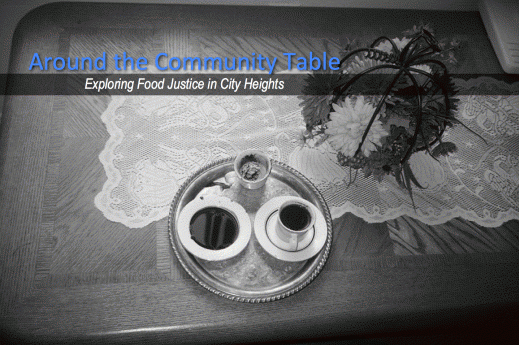Craft, organic coffee and specialty produce were once reserved for farmers markets and niche grocers in affluent neighborhoods. In City Heights, however, Agora Bean + Leaf sells specialty tea and coffee in chic packaging from the same row of stalls where refugees sell hot dishes prepared at home. Most of the hands seen jockeying for produce and testing ripeness at this farmers market are not new to the motions; they belong to refugee farmers who left their crops behind and Mexican immigrants who came here for work. Most are now buying the fruits and vegetables.
Though not typical candidates for boutique coffee, the residents of City Heights have made the market, now in its third year, a success. Their ability to sustain such an unlikely venture seems borne out of an industrious spirit carried with few tangible belongings from all over the world. Residents and community advocates have defied traditional ideas about what people in poor neighborhoods can eat, even becoming a national model with Michelle Obama’s visit to the New Roots Community Farm last year.
But these pockets of freshly turned soil and verdant greens are just pieces of a still-complicated picture of food access in City Heights—one that includes disproportionately high rates of obesity and diabetes. In a 2009 Mid-City CAN survey, residents called for immediate action to improve access to nutritious foods in their neighborhood.
Over the coming months, Speak City Heights will explore the work that still needs to be done. Our hunch is that, while healthy food is available in City Heights, the trouble lies in getting it home to dinner tables.
Emaciated budgets make stocking the cupboard difficult
The median household income in City Heights hovers around $25,000 a year, according to the U.S. Census Bureau. Public aid for new refugees is less than $1,000 for a family of four. Such emaciated budgets make stocking the cupboard difficult and filling the refrigerator with fresh options even harder.
The local International Rescue Committee has made significant strides in improving the affordability of quality produce with its Fresh Fund program, which doubles some residents’ budgets by matching food stamp, WIC and disability aid dollars spent at the farmers market. Community gardens have cropped up on once-vacant parcels and in schoolyards, reducing prices to a little sweat and time for those with plots.
But a disconnect still exists. For new refugees who spent years lining up for water in refugee camps and families with little money to spend, the convenience and satisfaction of filling bellies with quick, cheap food often trumps nutrition. What’s more, the concept of nutrition can be foreign when residents came from regions where processed foods and unhealthy snacks were never an option.
The perpetual arrival of new Americans to City Heights has prompted nonprofits to offer sustained health education through cooking classes, workshops and promatoras, residents trained to educate their neighbors in a home setting.
Convenience stores fill community pantries
Such programs, however, have little control over barriers outside of the home. Outdated development, poorly planned infill and inefficient transit keep many residents from accessing full-service grocery stores.
During the 1940s and 1950s, development in the area fanned out from thoroughfares designed for car-bound passersby. These thick boulevards left behind a legacy of liquor store neon that has yet to burn out. The corner markets along El Cajon Boulevard and University Avenue worked to feed families then, but they continue to stock area cupboards despite a growing emphasis on liquor and snack foods.
The problem was ignored when a new wave of developers began replacing tired homes with multi-family housing from the 1960s through the 1980s. The community’s only national grocer abandoned the community in 1994 and wasn’t replaced until 2000. Getting to that grocery store remains a challenge for many.
After suburbanites and their sedans left, low-income families—many without cars—moved in. According to Mid-City CAN, transit use in City Heights is more than four times the national average. Residents, however, consider their relationship with transit authorities a thorny one. People in City Heights have suffered cut after cut to services and stalled projects that slow travel to jobs where money can be made and to commercial centers where it can be spent on groceries. It took decades of advocacy work before the community learned this year that it will get bus services it has long fought for.
Land-use regulations starve community of change
Similar advocacy work will likely ensue as City Heights harnesses new interest from private and public grant-makers. The holes left in its food system by the automobile era remain in part because of staid land-use regulations. Previous reporting on food justice in San Diego showed that city and state policies inhibit the creation of community gardens and backyard chicken coops, and encourage the proliferation of liquor stores and fast food outlets.
Change depends on your voice
Speak City Heights aims to uncover and explain more of these barriers with your help. We invite you to use this website as a forum to tell the media, lawmakers and other San Diegans what’s keeping healthy food from your dinner table.
You can be heard by commenting on stories and participating in polls. And if you don’t see answers to your questions or coverage of the issues you care about, leave a comment on our message board or email spkcityheights@gmail.com.
Speak up, City Heights! We’re listening.

